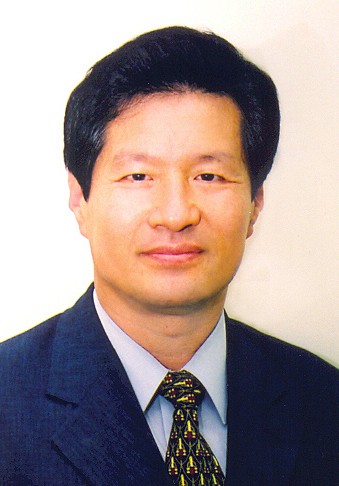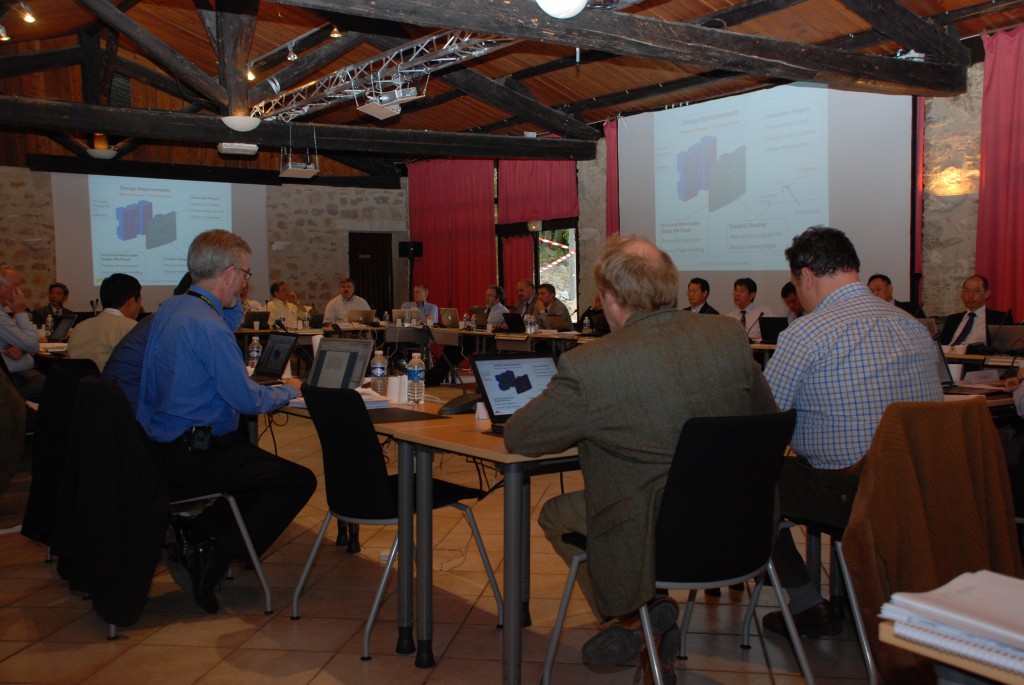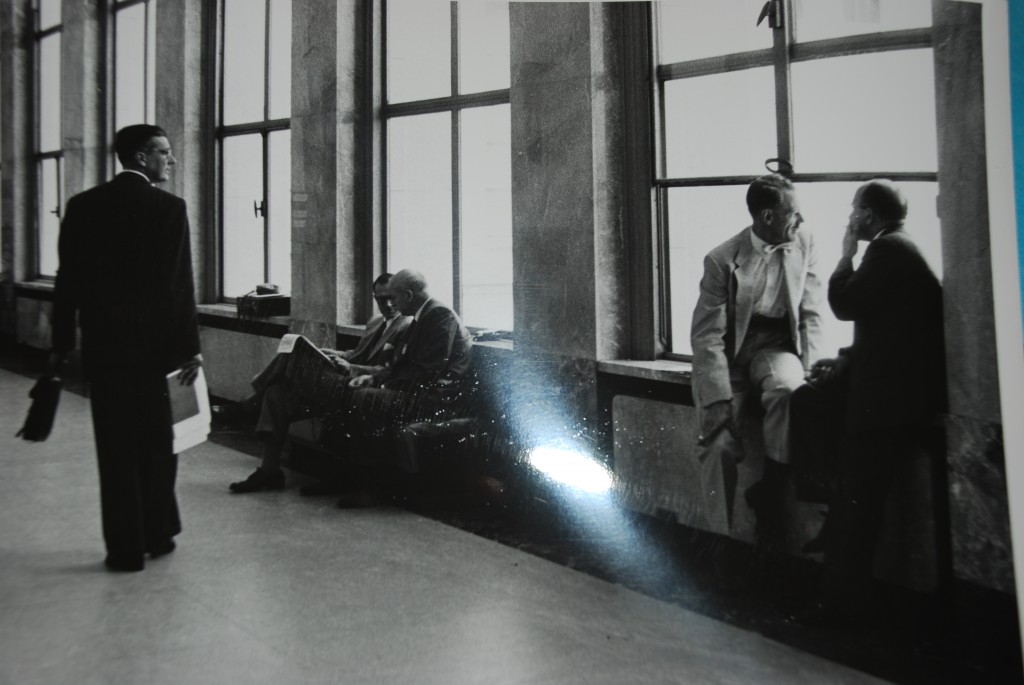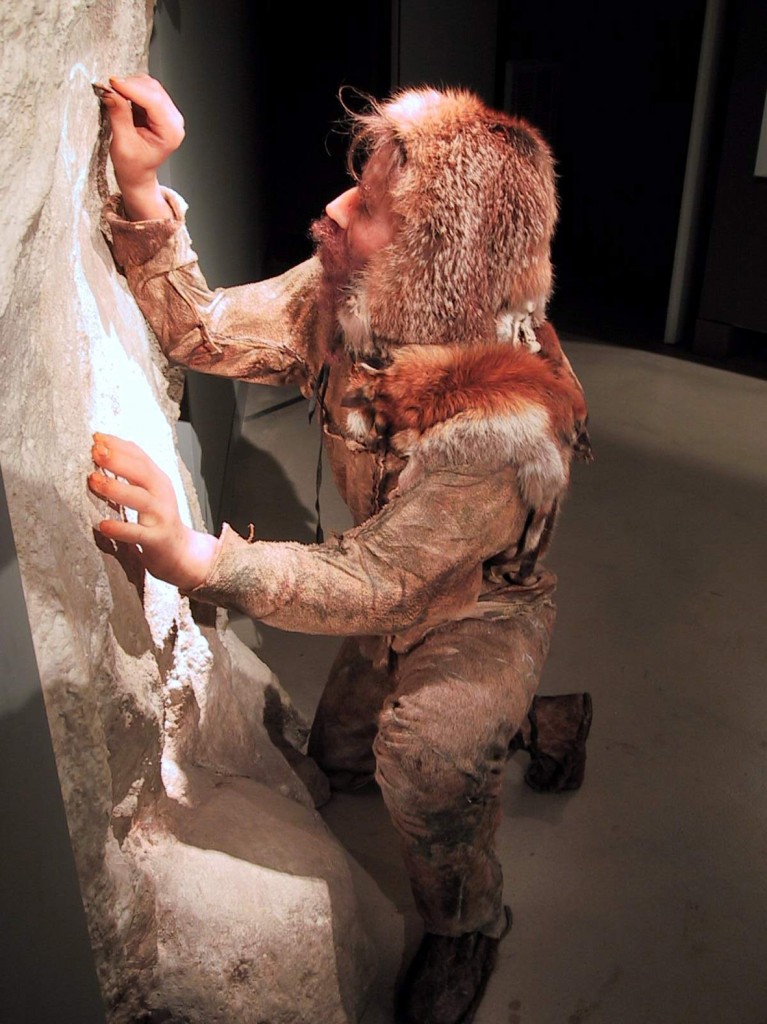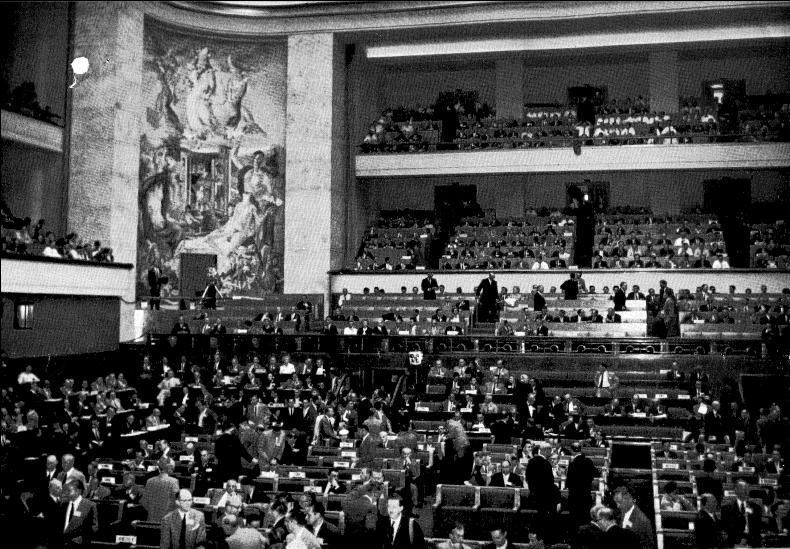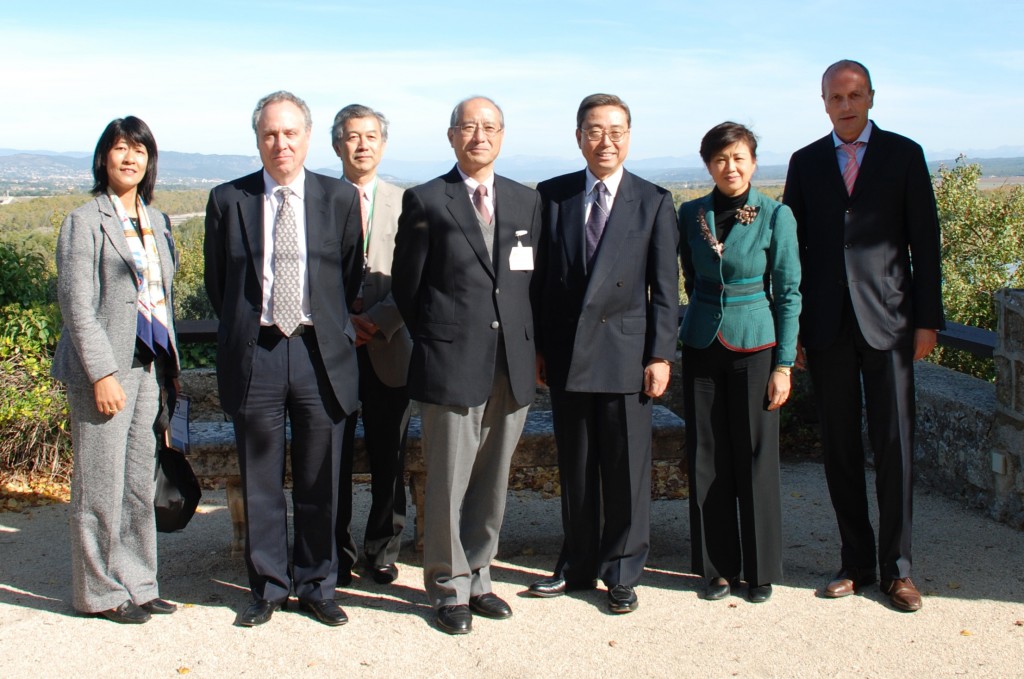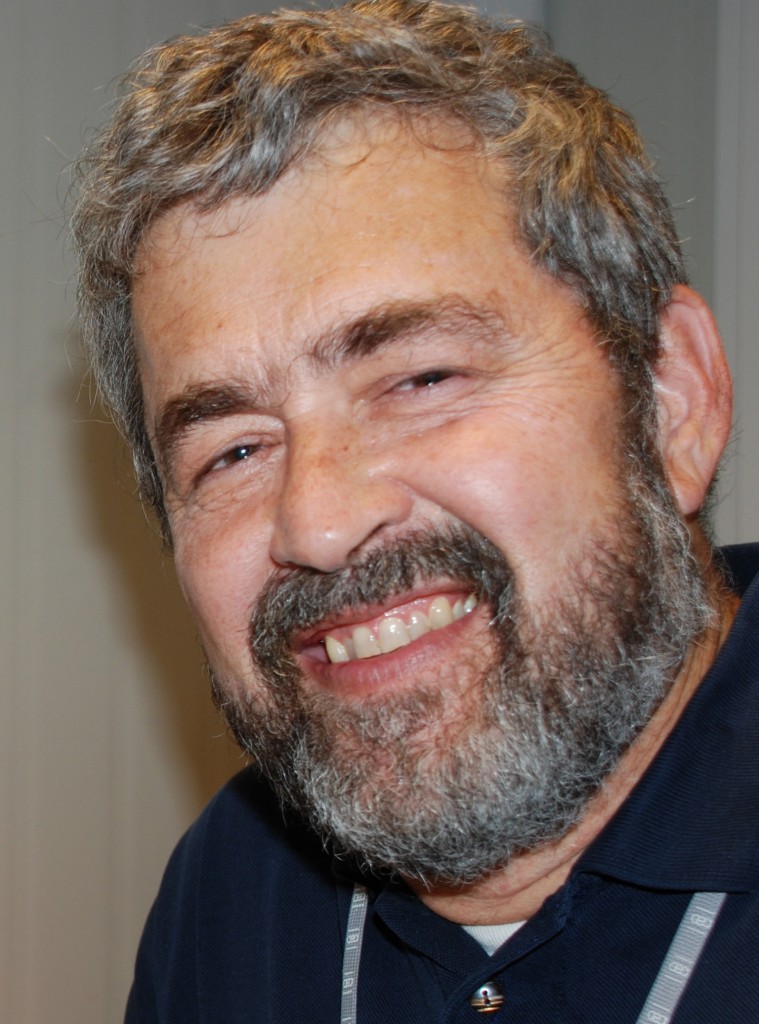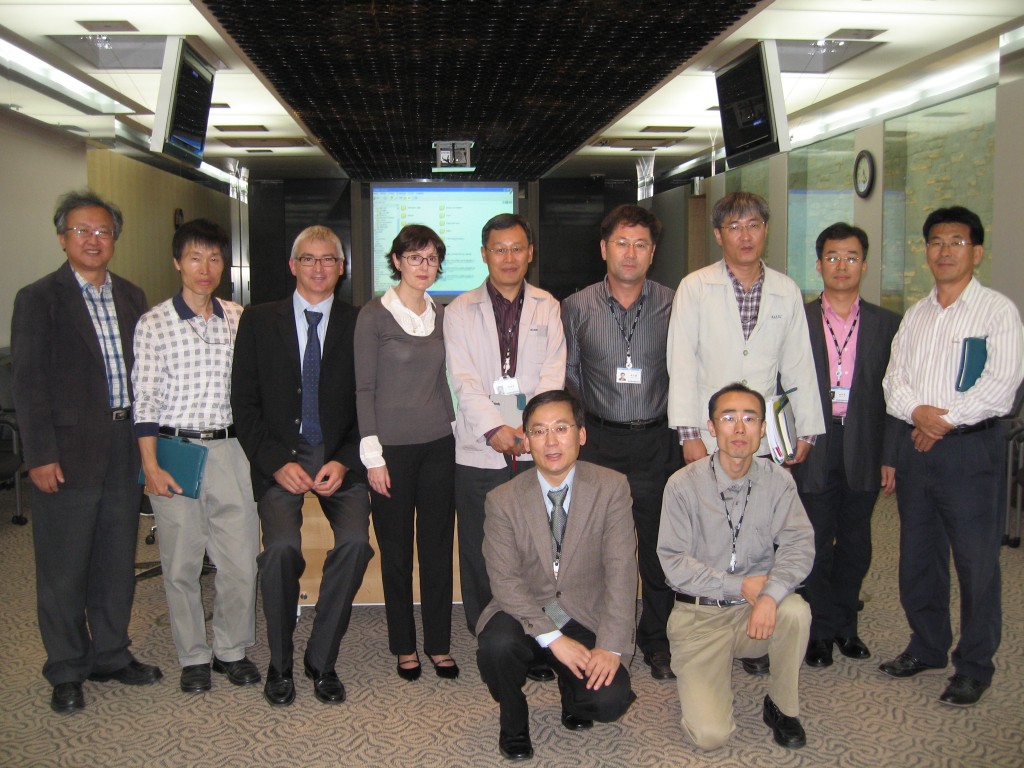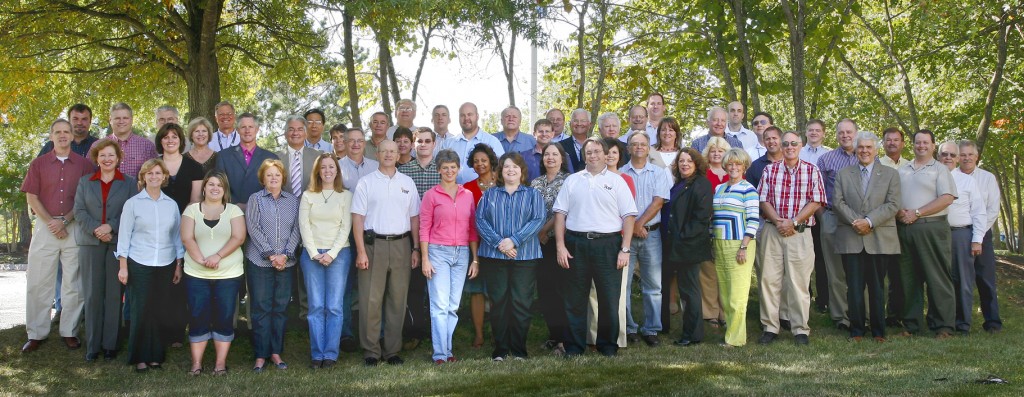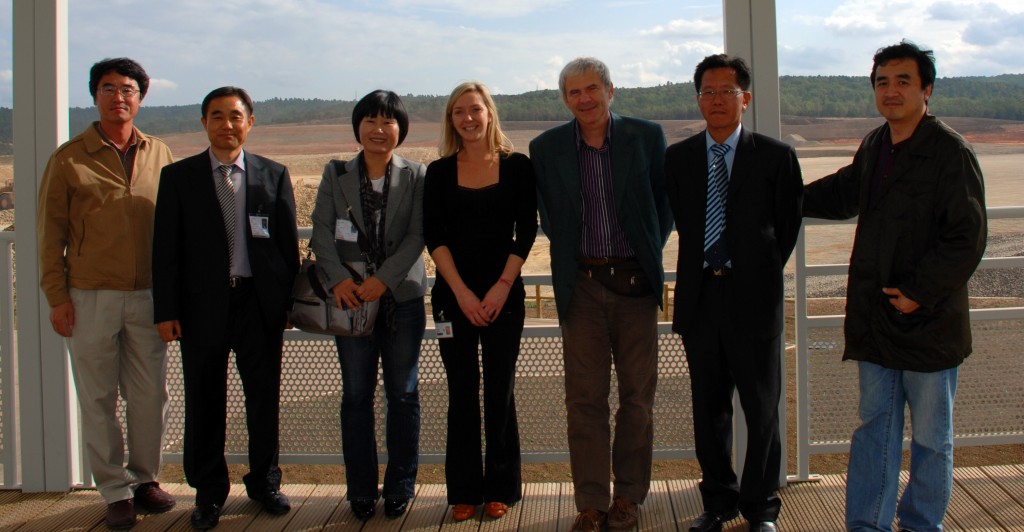Once again the medieval walls of the Château de Cadarache saw the ITER advisory committees—and thus the leaders of the world fusion community—convene to chart the course for ITER. Starting today, the Science and Technology Advisory Committee (STAC) came together for a three-day meeting to discuss the key technical issues such as the design and design integration of ITER's in-vessel coils, the testing of the poloidal field conductor, and recent calculations done on heat load specifications. Also on the STAC agenda are the Test Blanket Module program, the implementation of a RAMI analysis (Reliability, Availability, Maintainability and Inspectability) for technical risk control, and finally the proposal for an alternative vacuum vessel and blanket design. From Wednesday on, the Management Advisory Committee (MAC) will take over the Salle de la Fenière followed by the Council Preparatory Working Group and, on Sunday, by another ITER Organization-Domestic Agency meeting.
Some call it the "Olympics of Fusion Energy" and it certainly is the most important conference on every fusion scientist's agenda: the biennial Fusion Energy Conference hosted by the International Atomic Energy Agency (IAEA). The 22nd Fusion Energy Conference was a particularly special event as the conference had come back to Geneva to celebrate the 50th anniversary of the famous second "Atoms for Peace" conference (see article in this issue) held in that very same Palais des Nations at the United Nations Offices in the Swiss capital of Bern in September 1958.
In the historic assembly hall, more than 500 presentations and talks were given on the latest magnetic confinement experiments, fusion technology and power plant design, innovative concepts and also inertial fusion experiments and theory. A special session was dedicated to ITER activities with 10 presentations and 49 posters displayed for discussion. In addition 60 papers on ITER-related science and technology were submitted to this year's conference. ITER Director-General Kaname Ikeda, after signing the Cooperation Agreement with the IAEA, presented an update on the project's progress including the ongoing site preparation. Principal Deputy Director General Norbert Holtkamp then summarized the outcome of the design review and the impacts the technical updates will have on the ITER baseline design. The details were later picked up by the various ITER representatives in their talks that will be made available by the IAEA shortly here.
In a special evening session on Wednesday, the conference organizers celebrated the anniversary by looking back on the history of 50 years of magnetic confinement fusion research. The key speakers at this session were Jiangang Li, Dale Meade, Valentin Smirnov and Kunioki Mima.
While Smirnov took the lead marching through half a century of tokamak research in Russia, where the "toroidal chamber with magnetic coils" was born, Dale Meade literally took the next step. "We need one more experimental step, one more large tokamak to go from the experimental confinement results obtained by earlier experiments such as JET, TFTR or JT60 to ignition conditions," Dale said. "That step will now be fulfilled by ITER." And as it was the time to look back, Dale, a devoted advocate for fusion and the creator of the FIRE website, did not hesitate to show the correlation between the oil crises in the 1970s and the 1980s and fusion funding. "We have been ready for that step for 20 years. It is good that it is finally happening, but bad that it took so long."
Jiangang Li from China then caused some discussion among the audience, when he proposed a more cost-efficient approach to fusion by combining national efforts, perhaps even closing some of the current experiments in support of a few big projects. "Twenty-six years ago I was trained as a fission engineer," Jiangang Li ended. "And today I have a dream. In that dream I press a button and the light will turn on. Light powered by fusion energy."
Prehistoric men were not very different from us. They liked to live in sheltered, dry and sunny homes, preferably with a view and not too far from work—that is, from the hunting grounds and flint rocks which supplied them with food, clothing, weapons and tools.
Some 400,000 thousand years ago, such a group of men, not quite "sapiens" yet but on the verge of "discovering" fire, found just the place they were looking for: a large, deep cave with a wide terrace overlooking the Verdon River valley, close to what is now the village of Quinson.
Located 35 kilometers east of Cadarache, Baume Bonne—from the Provencal word "Baume," which means "cave"—is one of the earliest examples of an organized prehistoric habitat. Since the first settlements there, the cave has been home to various populations: pre-Neanderthals and Neanderthals, Homo Sapiens, Bronze Age groups, Neolithic herdsmen and Gallo-Roman communities. During the French Revolution, in the 1790s, the cave was transformed into a clandestine church where resistant priests celebrated mass. Archaeological explorations, which began in 1946, have brought to light some 80,000 prehistoric artefacts, from bone pins to the most elaborate flint blades.
Ten years ago, the General Council of Alpes-de-Haute-Provence commissioned world-renowned architect Sir Norman Foster to design a museum to host part of this outstanding collection and present to the public, through permanent and temporary exhibits, the million year "Adventure of Man" in Provence.
Architecturally daring, "echoing the concept of cave-dwelling" in a striking contemporary building, the Musee de Prehistoire des Gorges du Verdon is the largest prehistory museum in Europe. Both educational and fun, it is a spectacular showcase of our own beginnings.
In 1958, the United Nations Conference on the Peaceful Uses of Atomic Energy, which later became known as the second "Atoms for Peace Conference," performed the "unwrapping" of controlled nuclear fusion. The Geneva conference was a "Monster Conference" as Time Magazine wrote, with 5,000 scientists from 67 countries participating, plus 900 (!) accredited correspondents from all over the world, and 3,651 observers from industry and an even larger number of interested members of the public. The huge interest in the fusion conference was an ever bigger challenge to Geneva's hotels and guest houses that could only offer 6,500 beds at that time.
To prepare the fusion exhibits in the exhibition hall next to the Palais des Nations that was built specifically for that purpose, many scientists lived in Geneva for several months, some even accompanied by their families. " It was probably one of the largest scientific conferences that has ever been held," writes Gunther Mank, Section Head, Physics Section, Division of Physical and Chemical Sciences within the International Atomic Energy Agency (IAEA), in the extremely interesting brochure that he has put together on the occasion of the 50th anniversary of the "Monster" conference and that gives a picturesque impression of the enthusiasm and atmosphere of those days in September 1958.
Read more...
On 17 October, the newly-appointed Ambassador of Japan to the European Union, Nobutake Odano, together with the Councillor of Science and Technology of the Japanese Mission to the EU, Naoko Okamura, came to visit ITER and to meet members of ITER senior management.
If you ever wondered what's the reason for the siren that you hear every Thursday at 13h00, here is the answer: it is a test for the general alert of the CEA Centre that starts with an intermittent sound and ends with a continuous alarm. So, what should you do in case of an emergency? First of all, stay in the building you are in or enter the nearest building around; close all windows and doors and follow further instructions given through the loudspeakers; if required, take out the emergency mask and suit provided at the entrance of each building and put them on; if there are newcomers or visitors around, take care of them; use the telephone only for safety purposes.
So far, so good. If it is not a Thursday but a Wednesday and you hear a siren at midday, do not worry. This is another test alarm that is turned on precisely at noon every first Wednesday of the month. It's part of the Particular Intervention Plan (PPI) to alert the people living in the neighbourhood of Cadarache in the event of a nuclear accident at the CEA Centre.
|
The first five Principality of Monaco ITER Postdoctoral Fellowships have been awarded. The successful candidates are drawn from five of the seven ITER Member states and represent a range of skills in science and engineering in areas of importance to the ITER Project.
The Principality of Monaco ITER Postdoctoral Fellowships were established as a result of the collaboration agreement between the Principality of Monaco and ITER. The initial phase of the programme was launched in spring 2008 with an invitation to young researchers who had recently received their PhD, or were about to do so, to apply for an award. The call attracted 28 applicants from across the ITER Member research communities and industries. A short-list of 14 candidates was chosen for interview by a selection panel of ITER Deputy Director-Generals. It is anticipated that the five Fellows will take up their posts by January 2009.
In July 2007, the Interim ITER Council endorsed a proposal from the then Nominee Director-General, Kaname Ikeda, on the organization and implementation of the ITER physics activities. Among the key mechanisms was a call to establish a program on the integrated modelling of fusion plasmas. Implicit in this early directive was the recognition of the many challenges faced by integrated modelling.
The overall aims of this program are to meet the initial needs of the ITER Project for more accurate predictions of ITER performance and for efficient control of ITER plasmas, to support the preparation for ITER operation and, in the longer term, to provide the modelling and control tools required for the ITER exploitation phase.
Integrated modelling has many different aspects. Theoretical plasma physicists see the ultimate goal as the ability to predict reliably the behaviour of plasma discharges on all relevant time and space scales. Computational physicists see the complexity of the most advanced multi-physics nonlinear simulation models requiring petascale-class (1015 floating point operations per second), and ultimately exascale-class (1018 flops), computer facilities in order to span the relevant time and space scales.
"Currently we consider that transport processes are driven by micro-turbulence generated the thermal plasma," explains Wayne Houlberg, Head of the Integrated Modelling group within ITER. "But in ITER we expect the energetic alpha particles will drive additional transport through instabilities called Alfven eigenmodes. These Alfven eigenmode instabilities have been observed in current machines that are heated with energetic ions from neutral beam injection, and are generally fairly isolated and benign." However, in ITER they are expected to become much more important, especially in the later, high performance, stages. "In these conditions the modes that we now see in isolation may overlap and interact non-linearly. This is something that only a burning plasma such as ITER will be able to address; it is the type of physics that puts ITER in the category of a physics research facility rather than a DEMO facility."
Experimental plasma physicists see it as unifying the simulation of plasma behaviour in the core, edge, scrape-off layer and divertor along with the interaction between the plasma and the plasma-facing components. To machine operators, the challenge is to steer the evolution of the plasma by effective use of auxiliary systems—heating, fuelling, current drive and magnetics—through the start-up, flat-top and shut-down phases while avoiding regimes of undesirable behaviour.
The control algorithms for this must incorporate very efficient descriptions of the physics in order to effect a timely response. If you are a modeller sitting at a terminal, integrated modelling is everything you can fit into a calculation that produces results in a reasonable amount of clock time. The patience of modellers varies from the time between cups of coffee to a night to sleep on it.
All of these conditions describe aspects of integrated modelling that are relevant to present experimental devices. The ITER integrated modelling program is being designed to accommodate these as well as new challenges: simulating the physics of a largely self-driven system with new behaviour expected to result from energetic fusion products, incorporating the safety and operational constraints of a nuclear environment, and assembling a cohesive team from the diverse ITER Members.
A bit like climate modelling
Talking about the technical aspect of this effort, how will this joint effort be realized? "This is indeed a real challenge," replies Houlberg. "ITER will not have the computer facilities or personnel to do it all. We envisage establishing connections to various computational networks to enable the more advanced modelling. The most detailed models that require petaflop and eventually exaflop capabilities will be performed by external users in the ITER Members fusion programs, using links to ITER data and analysis capabilities. This is one aspect of the collaborative effort between the ITER Organization and ITER Members. As in climate modelling, for example, these detailed calculations would be used to calibrate/validate the simpler, faster models that are used in more routine scoping, planning and analysis of ITER plasmas. And as these R&D models are validated and computing facilities allow, they can be migrated to the standard ITER suite of integrated modelling codes."
The development of the ITER integrated modelling program will rely heavily on the relevant expertise within the Members' fusion programs, building to the greatest extent possible on existing coordination structures within the Member programs. It will include adaptation of existing physics codes, physics code development, development of a modelling infrastructure, benchmarking and validation activities. The infrastructure is being designed to accommodate the expected evolution of the physics and interaction with auxiliary and control systems over the expected 30-year life of the project and serve as a solid basis for the design of DEMO.
So far, the procurement allocation does not foresee a Korean contribution to the ITER Hot Cell Facility. This building, needed for maintenance and radwaste operations of the ITER machine, will be financed 100 percent by the European Domestic Agency as defined in the procurement sharing plan. But things are about to change. The ITER Organization is currently undergoing a major value engineering process with the goal of reducing the overall project cost. So closer cooperation between the ITER Organization and the Domestic Agencies is desirable and necessary in many areas.
To start with, a delegation from ITER visited the Korean Atomic Energy Research Institute (KAERI) in Daejeon. As the Korean KAERI has years of experience to offer in the field of hot cell operation, ITER and Korea are currently discussing possible means on how to benefit from Korea's expertise on nuclear hot cells to help the ITER Organization optimize the design and thus reduce the cost of the ITER Hot Cell Facility.
The US ITER Project Office holding a pizza party — an opportunity for a group photo.
Monday, 20 October, a delegation from NFRI KSTAR Korean Research Centre visited the ITER construction site. (From left to right): Chang Ho CHOI (ITER IO), M. Joo Shik PARK (Director General KSTAR Research Centre), Mrs Mi Kyung PARK (team leader KSTAR Research Centre), Mrs Marina Bayle and M. Jean Michel Bottereau (Agence ITER France),M. Hyung Yeol YANG (Division Head KSTAR Research Center), M. Woong Chae KIM (Team Leader KSTAR Research center).
|


